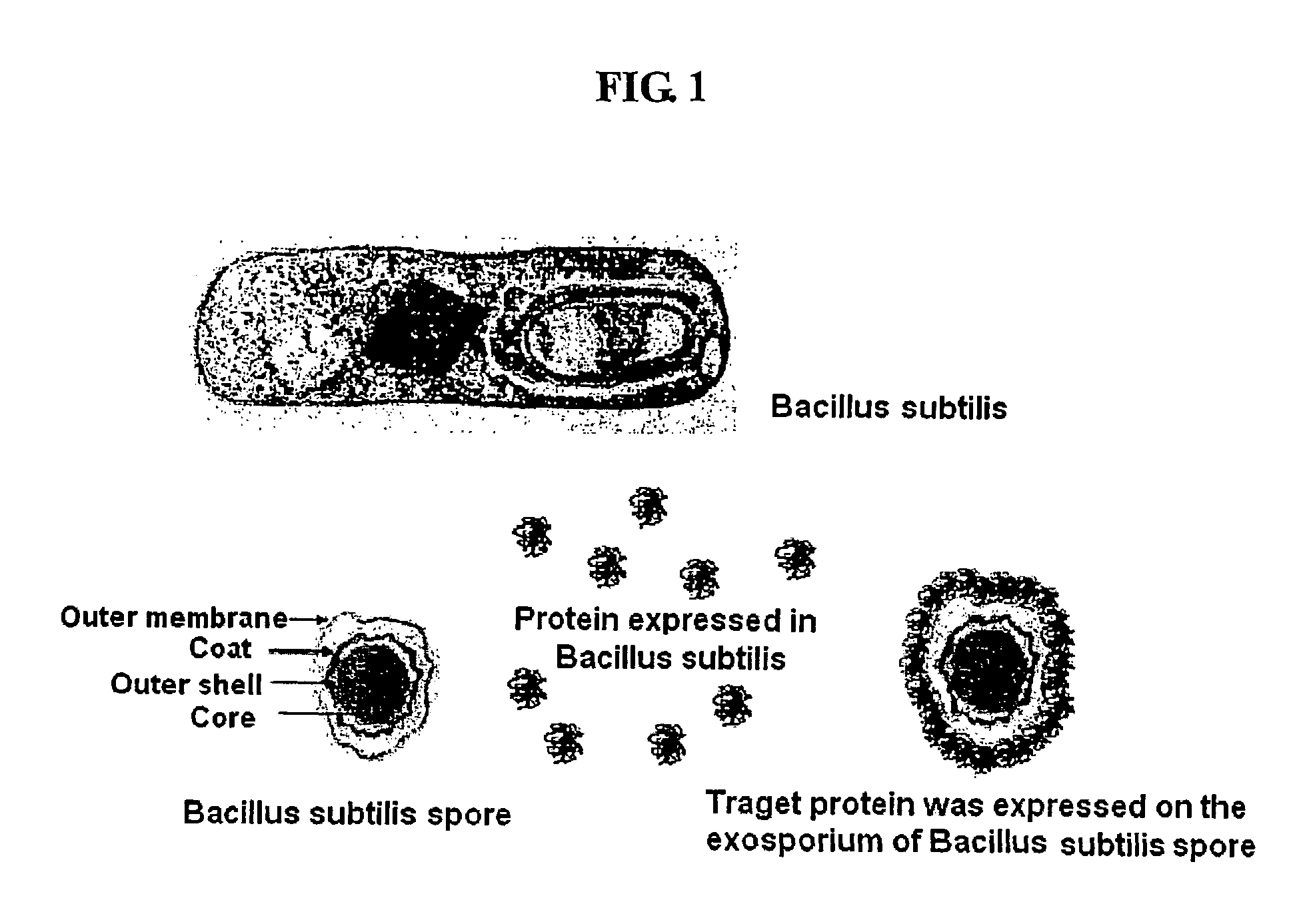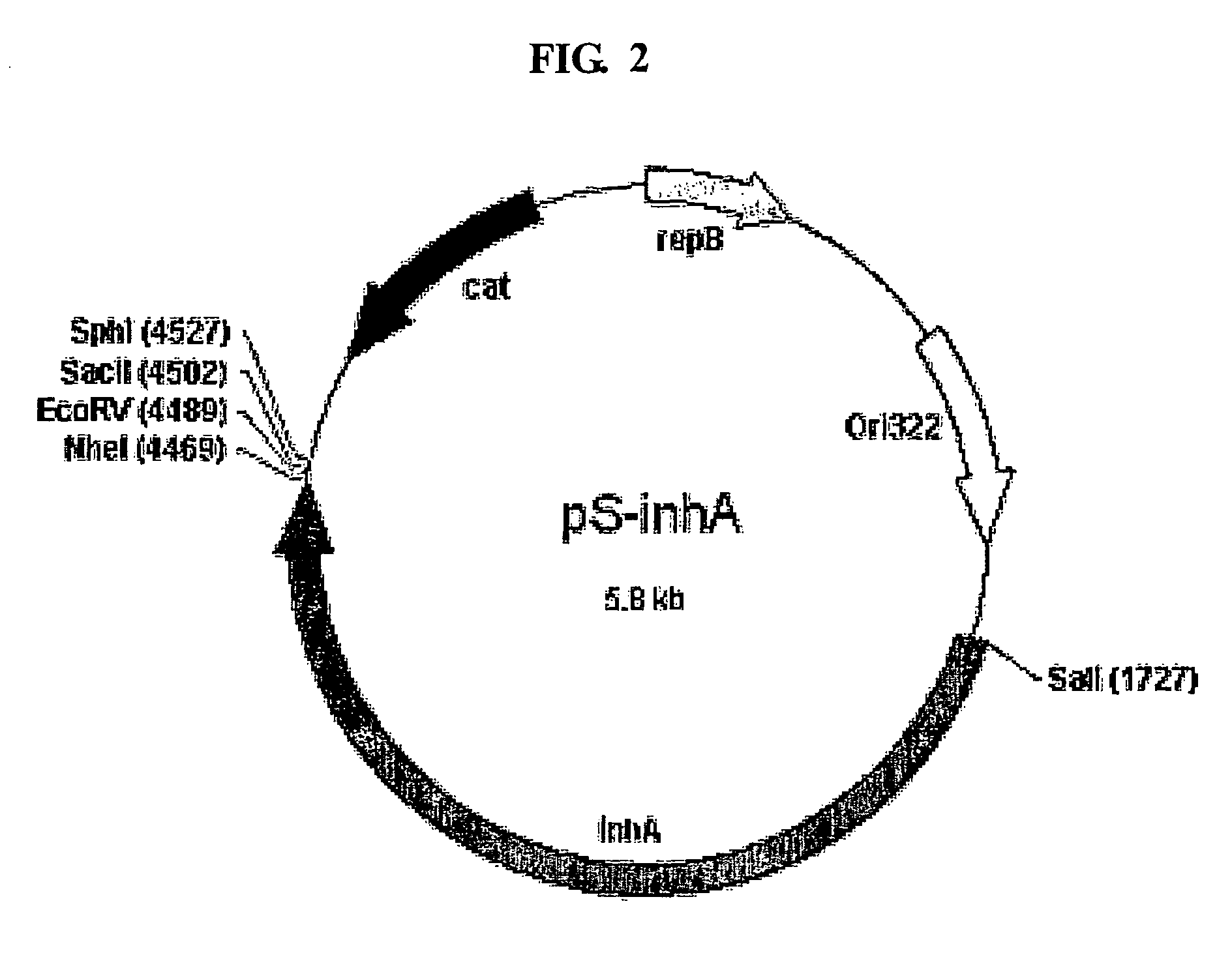Method for whole surrounding surface display of target proteins using bacterial exosporium
a technology of target proteins and exosporium, which is applied in the field of whole surrounding surface display of target proteins using bacterial exosporium, can solve the problems of structural limitation, inability to form stable membrane proteins, and low surface expression of screened antibodies from a library expressed on the surface of phages, so as to achieve easy separation, increase cohesiveness, and increase the effect of cohesiveness
- Summary
- Abstract
- Description
- Claims
- Application Information
AI Technical Summary
Benefits of technology
Problems solved by technology
Method used
Image
Examples
example 5
Expression of Green Fluorescent Protein on Surface of Spore Outer Membrane
[0076]To express an enhanced green fluorescent protein (EGFP) on the surface of the spore outer membrane constituting the outermost portion of spores, the EGFP gene was inserted into the plasmid pS-InhA of Example 2. The resulting recombinant plasmid was introduced into Bacillus subtilis DB104 and cultured as in Example 3 to obtain spores. In order to examine if EGFP was expressed on the surface of the spore outer membrane, the surface-expressed EGFP was examined by CLSM (confocal laser scanning microscope; Carl Zeiss LSM 410, Germany). FIG. 10 is a photograph of EGFP taken by exposure to an argon laser with 488 nm wavelength. From this result, it could be found that EGFP was normally expressed on the spore surface.
example 6
Patterning of Spores for Surface Expression
[0077]First, streptavidin was reacted on a slide glass on which biotin and poly(ethyleneglycol)amine (MW 5000) have been patterned. This gives a substrate on which streptavidin was patterned (FIG. 11).
[0078]Meanwhile, the patterning of the cells and spores using EGFP, which have been surface-expressed in a fused form with the exosporium prepared in Example 5, was embodied. For this, an antibody specifically binding to EGFP was first reacted with the spores having the EGFP expressed on their surface, and then, the binding of the antibody to protein A was induced using a substance where the protein A is fused to biotin. Then, the resulting substance was reacted on the streptavidin-patterned substrate to induce the patterning of the spores (FIG. 12). The patterned spores were cultured in an LB agar medium for about 8-16 hours so that they were grown into vegetative cells (FIG. 13). This indicates that the patterning of live cells became possib...
example 7
Protein Array Using Gene Carriers Having Target Protein Expressed on their Surface
[0079]106-109 gene carriers having EGFP expressed on their surface were attached to the surface of a slide glass (CEL Associates Co., USA) coated with an aldehyde functional group, by means of an automated arrayer. In this case, an amino group present on the protein of the gene carrier surface was reacted with the aldehyde group present on the slide glass surface to form a schiff-base, so that the gene carriers were covalently attached to the solid surface for protein arrays and protein chips. FIG. 14 is a fluorescent photograph for the protein arrayed EGFP and it after reaction with polyclonal antibody against GFP. Although the target protein expressed on the surface of the spore outer membrane was attached to the solid surface to lose its activity, it could be found that the target protein expressed on the spore outer membrane of the gene carriers has a constant direction. Accordingly, the protein ar...
PUM
| Property | Measurement | Unit |
|---|---|---|
| wavelength | aaaaa | aaaaa |
| wavelength | aaaaa | aaaaa |
| surface expression | aaaaa | aaaaa |
Abstract
Description
Claims
Application Information
 Login to View More
Login to View More - R&D
- Intellectual Property
- Life Sciences
- Materials
- Tech Scout
- Unparalleled Data Quality
- Higher Quality Content
- 60% Fewer Hallucinations
Browse by: Latest US Patents, China's latest patents, Technical Efficacy Thesaurus, Application Domain, Technology Topic, Popular Technical Reports.
© 2025 PatSnap. All rights reserved.Legal|Privacy policy|Modern Slavery Act Transparency Statement|Sitemap|About US| Contact US: help@patsnap.com



